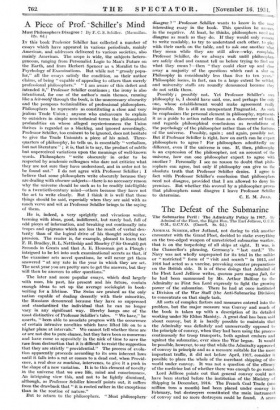The Defeat of the Submarine
The Submarine Peril : The Admiralty Policy in 1917. By Admiral of the Fleet, the Right Hon. The Earl Jellicoe, G.C.B. G.C.V.O. (Cassell. 85. 6d.)
ADMIRAL SCHEER, after Jutland, not daring to risk another encounter with the Grand Fleet, decided to stake everything on the two-edged weapon of unrestricted submarine warfare, that is on the torpedoing of all ships at sight. It was, in the Chancellor's phrasing, Germany's " last card." The Navy was not wholly unprepared for its trial in the milder or " restricted " form of " visit and search " in 1915, and 1916 had acted as a vaccine, provoking counter preparations on the British side. It is of these doings that Admiral of the Fleet Lord Jellicoe writes, quorum pars magna fait, for he had been summoned by Mr. Arthur Balfour to the Admiralty as First Sea Lord expressly to fight the growing power of the submarine. There he had at once instituted a Division of the War Staff (the Anti-Submarine Division) to concentrate on that single task.
All sorts of complex factors and measures entered into the problem, but the major measure was Convoy and much of the book is taken up with a description of its detailed working under Sir Eldon Manisty. A great deal has been said about convoy, but it is hardly possible to maintain that the Admiralty was definitely and unreservedly opposed to the principle of convoy, when they had been using the process continuously for troop transports, both against cruisers and against the submarine, ever since the War began. It would be possible, however, to say that while the Admiralty approved of convoy in principle and as a measure suitable for the more important traffic, it did not before April, 1917, consider it possible to place the whole of the merchant shipping of the world under convoy. It was not a question of the efficacy of the medicine but of whether there was enough to go round. Lord Jellicoe. points out that general convoy could not have been started before the institution of the Ministry of
Shipping in December, 1916. The French Coal Trade (one. Million tons a month) had been placed under convoy in F.ehruary, but destroyers constituted the main instrument of convoy and no more destroyers could be found. A score or so had been taken from the Grand Fleet, but Admiral Beatty's command was nothing less than the shield behind which the whole War was fought, and the limit in that direction had been reached. It was not till April, 1917, when America came into the War, and American destroyers helped to bridge the gap, that Lord Jellicoe was able to solve the twin problem of a sufficiency of destroyers and the provision of assembly ports oversee.
Convoy, however, was not the only measure. An advance was made along a number of other paths—the development of hydrophones, the building of P-boats, the design of improved depth-charges and new mines, the reorganization of the Naval Staff, the institution of a Minesweeping Division, and a Plans Division, the provision of a Salvage organization, a general tightening up of organization and a wider diffusion of intelligence (surely the work of the Naval Intelligence Division was one of the bright jewels of the War). It is clear that some of these factors were beginning to tell before general convoy started, for in May, 1917, the figures of sinkage had dropped by 284,000 tons from the " peak " month of April. There was a gradual drop too in the Mediterranean, though " through " convoys in that sea did not start till October, 1917.
In December, 1916, it had been calculated by the German Naval Staff that a sinkage of 600,000 tons a month could bring England to her knees in five months. They attained that sinkage very nearly (an average of 500,000 tons a month up to June, 1917) and, had they been able to maintain it, the end of the year would have seen the end of traffic by sea and the whole structure of the War on the Allied side collapsing like a house of cards. But by the autumn the big wheels of convoy were running, new mines were corning in by thousands and all the measures that defeated the submarine were under way and gathering impetus.
By the end of 1917 it was felt in the Admiralty that the submarine had shot its bolt. The Chancellor's " last card " had been trumped. The work was done under Lord Jellicoe and the main impetus was supplied by the Division that he had himself created with the late Admiral Sir Alexander Duff at its head. It is admitted by the German historians that the defeat of the submarine meant the defeat of Germany. Two hundred German submarines were destroyed, chiefly by British agency.
The magnitude of the issues at stake is worthy of the perora- tion of Thucydides : " This was the greatest of all the achieve- ments and events of the War, the most decisive for the victors, the most ruinous for the conquered. For they were utterly defeated and swept from the sea and out of their great host few returned home." The life of a Flanders submarine in 1918 was estimated at five to six cruises.
A. C. DEWAR.







































 Previous page
Previous page